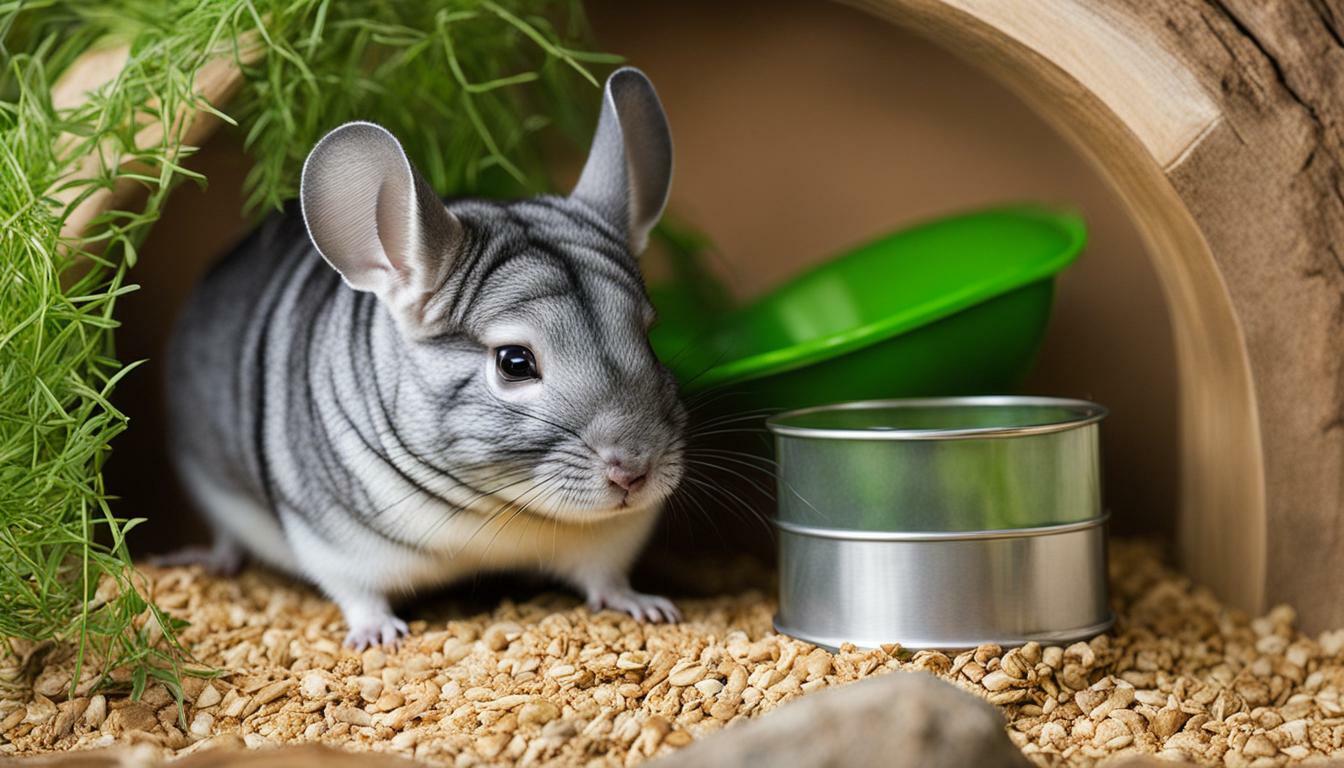Chinchillas are delicate creatures that require specific living conditions to thrive, but can they live outside?
Key Takeaways:
- Chinchillas cannot live outside due to their sensitivity to temperature changes and the risk of exposure to wet conditions or infections.
- They need a cool, controlled environment away from direct sunlight.
- Walks outside are not recommended due to the potential dangers they may encounter.
- Chinchillas should be provided with indoor exercise options like toys, ledges, and wheels.
- If an outdoor situation is necessary, it should be temporary and in a cooler environment such as a car or carrier cage.
The Sensitivity of Chinchillas to Temperature Changes
Chinchillas have a low tolerance for temperature changes, making an outdoor environment unsuitable for them to live in. These adorable creatures come from the Andes Mountains in South America, where they are accustomed to cold temperatures and high altitudes. Thus, they are highly sensitive to heat and humidity. Chinchillas thrive in a cool, controlled environment away from direct sunlight and extreme temperatures.
Exposing chinchillas to hot and humid conditions can have detrimental effects on their health. They are prone to heat stroke and can easily become overheated, leading to severe dehydration and even death. It is crucial to provide them with a consistent, cool environment, ideally between 60°F and 70°F (15°C-21°C).
| Temperature | Effect on Chinchillas |
|---|---|
| Below 50°F (10°C) | Chinchillas are comfortable. |
| 50°F-60°F (10°C-15°C) | Chinchillas are still comfortable, but be cautious of lower temperatures. |
| Above 70°F (21°C) | Chinchillas are at risk of overheating and heat stroke. |
| Above 85°F (29°C) | Chinchillas are in serious danger and can suffer from heat exhaustion or even death. |
Providing a cool and controlled indoor environment is essential to keep chinchillas healthy and happy. Ensure their habitat is well-ventilated, away from drafts, and not exposed to direct sunlight. Additionally, it is crucial to monitor the temperature regularly and make adjustments to provide a safe and comfortable environment for your furry friends.
The Risk of Exposure to Wet Conditions or Infections
Living outside puts chinchillas at risk of exposure to wet conditions or infections, which can be detrimental to their health. Chinchillas have delicate fur that is not well-suited to wet environments. When exposed to moisture, their fur becomes damp and can develop mold or fungus, leading to skin infections or respiratory issues. Additionally, chinchillas are prone to allergies, and damp conditions can exacerbate their symptoms, causing discomfort and potential health complications.
Furthermore, chinchillas are highly susceptible to respiratory infections. Cold and damp air can irritate their sensitive respiratory systems, making them more prone to developing infections such as pneumonia. Similarly, their delicate immune systems can be compromised when exposed to wet conditions, making it difficult for them to fight off infections.
To ensure the well-being of your chinchilla, it is crucial to provide them with a dry and controlled environment. This means keeping them indoors where the temperature and humidity can be regulated. Avoid placing their cages near windows or areas with high moisture levels, such as bathrooms or laundry rooms. By doing so, you can minimize the risk of your chinchilla coming into contact with wet conditions or developing infections that could potentially harm their health.
| Risks of Wet Conditions and Infections for Chinchillas |
|---|
| Damp fur can develop mold or fungus |
| Increased risk of respiratory infections |
| Potential allergy complications |
| Delicate immune system compromised |
By providing a dry and controlled environment, you are ensuring the well-being of your chinchilla and reducing their risk of health issues associated with wet conditions or infections. Remember, a comfortable and safe indoor space is essential for their overall health and happiness.
The Importance of a Cool, Controlled Environment
Chinchillas require a cool, controlled environment to maintain their well-being, which cannot be provided in an outdoor setting. These small furry creatures are highly sensitive to temperature changes and can easily become overheated or chilled if exposed to extreme weather conditions.
Direct sunlight is also a concern for chinchillas as it can quickly raise their body temperature to dangerous levels, leading to heat stroke and other health issues. In addition to temperature regulation, chinchillas need a controlled environment to avoid exposure to wet conditions. Their dense fur retains moisture, making them susceptible to skin infections and respiratory problems.
To keep your chinchilla healthy and comfortable, it is essential to provide them with a dedicated indoor living space. This can be a specially designed chinchilla cage or a room in your home that is free from drafts, excessive heat or cold, and direct sunlight. Ensure there is proper ventilation to prevent the buildup of ammonia from their waste, which can cause respiratory issues.
Creating a Chinchilla Playpen
Within their indoor environment, it’s important to give chinchillas the opportunity for exercise and mental stimulation. A great way to achieve this is by creating a chinchilla playpen. This can be done by using a designated space in your home or setting up a playpen enclosure.
When setting up a playpen, make sure to use safe flooring materials, such as fleece or cardboard, to protect your chinchilla’s sensitive feet. You can also include various toys, tunnels, ledges, and structures for them to climb on and explore. This will provide them with the exercise they need to stay physically healthy and prevent boredom.
Remember to supervise your chinchilla while they are in the playpen to ensure their safety and to prevent them from accessing any potential hazards in your home. Always keep an eye out for hidden spots, chewable cords or wires, and standing water that they may be tempted to explore.
| Item | Notes |
|---|---|
| Toys | Provide a variety of toys to keep your chinchilla mentally stimulated. Options include chew toys, wooden blocks, and puzzle toys. |
| Ledges and Platforms | Chinchillas love to climb and jump, so including ledges and platforms in their playpen will give them opportunities to engage in these natural behaviors. |
| Hideouts | Creating hiding spots will make your chinchilla feel safe and secure. Use tunnels, boxes, or fabric hammocks as cozy retreats. |
| Exercise Wheel | Chinchillas are known for their high energy levels, so providing an exercise wheel will give them an outlet for their boundless energy. |
The Risks of Going on Walks Outside
While it may seem tempting to take your chinchilla for a walk outside, it is best to avoid it due to the risks they may face. Chinchillas are delicate creatures with a high sensitivity to temperature changes, making them vulnerable to extreme heat or cold. Additionally, their small size puts them at risk of encountering aggressive animals or getting injured. Even the act of putting a leash or harness on a chinchilla can potentially harm their fragile bones.
Instead of outdoor walks, it is important to provide your chinchilla with plenty of indoor exercise options. They are active animals and need opportunities to run, climb, and play. Consider providing them with toys, ledges, and a wheel specifically designed for their size. These indoor options not only keep them physically active but also mentally stimulated.
In cases where an outdoor situation is necessary, such as moving them to a different location or taking them to the vet, it is crucial to ensure they are in a controlled, cool environment. A car or a carrier cage can provide temporary shelter while keeping them safe from extreme temperatures or exposure to wet conditions. Remember, outdoor situations should always be kept to a minimum and for short durations to prevent any potential harm to your chinchilla.
What to Do If a Chinchilla Escapes Outside
If your chinchilla accidentally escapes outside, it is important to stay calm and act swiftly. Chinchillas are naturally skittish and may be frightened by their unfamiliar surroundings. Begin by searching the immediate area, using treats or toys that they are familiar with to lure them out of hiding. It is important not to panic or make any sudden movements that could scare them further.
If your chinchilla does not come back on its own, consider setting up a trap using a humane live animal trap or a secure area where they can be safely contained. You can also reach out to local animal shelters or chinchilla rescue organizations for guidance and support in locating your chinchilla.
Prevention is key to avoid such situations. It is not recommended to let chinchillas roam freely in the home. They can easily find hidden spots that are difficult to access, chew on cords, or even gain access to standing water. Instead, create a chinchilla playpen with safe flooring and various toys and structures for them to climb on and explore. This allows them to safely exercise and satisfy their natural instincts without the risk of injury or escape.
| Risks of Going on Walks Outside: |
|---|
| High sensitivity to temperature changes |
| Potential encounters with aggressive animals |
| Risk of injury from leash or harness |
Indoor Exercise Options for Chinchillas
In an indoor environment, chinchillas can engage in various exercise options that promote their physical and mental well-being. These small and lively creatures need plenty of opportunities to stay active and entertained. By providing them with the right toys and structures, you can keep them stimulated and prevent boredom.
One popular exercise option for chinchillas is the use of toys. Chinchillas enjoy toys that they can chew on, such as wooden blocks or apple sticks. These not only keep their teeth healthy but also provide a form of mental stimulation. Additionally, you can introduce puzzle toys that hide treats inside, encouraging them to use their problem-solving skills to retrieve the rewards.
Another option is to provide chinchillas with ledges and platforms in their enclosure. These structures allow them to climb, jump, and explore their surroundings. You can place different levels at varying heights to provide a challenging and interesting environment. Just ensure that the ledges are stable and securely attached to prevent accidents.
A wheel is another great exercise option for chinchillas. Chinchilla-specific wheels with solid running surfaces are available, which prevent their delicate feet from getting caught. Running on a wheel allows them to burn off excess energy and maintain their physical fitness. Ensure that the wheel is of an appropriate size and that it spins smoothly without any resistance.
| Toys | Ledges and Platforms | Wheel |
|---|---|---|
| Wooden blocks, chew toys, puzzle toys | Sturdy ledges and platforms at varying heights | Chinchilla-specific wheel with a solid running surface |
| Provide mental stimulation and promote healthy teeth | Allow climbing, jumping, and exploration | Burn off excess energy and maintain physical fitness |
Remember, chinchillas are active animals and require daily exercise to stay happy and healthy. It’s important to ensure their environment is enriched with a variety of exercise options. By providing toys, ledges, and a wheel, you can create a stimulating and enjoyable space for your chinchilla. Regularly rotate and introduce new toys to prevent boredom and keep them engaged. With these indoor exercise options, you can help your chinchilla lead a fulfilling and active life.
Temporary Outdoor Situations
In certain situations, a temporary outdoor setup in a cooler environment may be required for your chinchilla’s well-being. However, it is important to note that chinchillas are highly sensitive to temperature changes and can easily become stressed or develop health issues if exposed to extreme heat or cold. Therefore, any outdoor time should be limited and carefully supervised to ensure your chinchilla remains safe and comfortable.
If you need to provide your chinchilla with some fresh air and a change of scenery, consider setting up a temporary outdoor situation in a shaded area, away from direct sunlight. A well-ventilated car or a carrier cage can be suitable options, as they provide a controlled environment that can be easily monitored. Ensure that the temperature remains within the range of 60-70 degrees Fahrenheit (15-21 degrees Celsius) to prevent any temperature-related problems.
| Important Considerations for Temporary Outdoor Setups |
|---|
| 1. Shade: Provide ample shade to protect your chinchilla from direct sunlight, which can quickly cause overheating. |
| 2. Ventilation: Ensure there is proper airflow to prevent the buildup of heat and humidity within the enclosure. |
| 3. Time Limit: Limit the duration of outdoor time to a maximum of 30 minutes to prevent stress and discomfort. |
| 4. Supervision: Never leave your chinchilla unattended during outdoor time to ensure their safety. |
Conclusion
While chinchillas are not suited to live outside, a temporary outdoor situation can be arranged in a cooler environment under careful supervision. However, it is crucial to prioritize their safety and well-being by providing adequate shade, proper ventilation, and limited exposure to the outdoors. Remember, the comfort and health of your chinchilla should always be your top priority.
What to Do If a Chinchilla Escapes Outside
In the unfortunate event that your chinchilla escapes outside, it is important to act quickly and calmly to ensure their safe return. Chinchillas are small and sensitive animals, and being in an unfamiliar environment can be stressful for them. Here are some steps you can take to increase the chances of finding your chinchilla and bringing them back home safely:
- Stay calm: It’s natural to feel panicked when your chinchilla escapes, but staying calm is essential. Panicking can make it harder to think clearly and search effectively. Take a few deep breaths and focus on the task at hand.
- Search the immediate surroundings: Start by searching the area where your chinchilla was last seen. Look under furniture, behind curtains, and in any small, enclosed spaces where they might hide. Chinchillas are excellent at finding hiding spots, so be thorough in your search.
- Use treats or toys to lure them out: Chinchillas can be enticed by the sound of their favorite treat or the sight of their favorite toy. Place some treats or toys around the area where your chinchilla was last spotted. The familiar scent or sight may encourage them to come out of hiding.
- Enlist help and expand the search: If you’re unable to locate your chinchilla on your own, ask family members or friends for help. Having additional pairs of eyes can greatly increase the chances of finding your chinchilla. Expand the search to other rooms in your home, and consider asking neighbors if they’ve seen any signs of your furry friend.
Remember, preventing your chinchilla from escaping in the first place is the best course of action. Ensure their enclosure is secure and regularly check for any potential escape routes. By providing a safe and stimulating indoor environment with plenty of exercise options, you can minimize the chances of your chinchilla wanting to venture outside. In the event of an escape, follow these steps and remain persistent in your search. With patience and diligence, you’ll increase the likelihood of a happy reunion with your beloved chinchilla.
Hazards of Letting Chinchillas Roam Freely in the Home
While it may be tempting to let your chinchilla roam freely in your home, it can pose significant hazards to their safety and well-being. Chinchillas are curious creatures with a penchant for exploration, but the risks associated with unrestricted roaming cannot be overlooked. By understanding these hazards, you can ensure the best possible environment for your furry friend.
One of the main dangers of letting chinchillas roam freely is the presence of hidden spots. Chinchillas are experts at squeezing into small spaces, and once they find a hiding spot, they can be difficult to locate. This can lead to stressful situations when you need to retrieve them or even result in accidental injury if they get stuck or trapped.
Another hazard is the potential for chinchillas to chew on cords. They have a natural instinct to chew, and electrical cords can be particularly enticing. Not only can this be dangerous for the chinchilla, but it can also lead to electrical hazards such as short-circuits or fires. It is crucial to keep cords out of their reach or use protective coverings to prevent chewing accidents.
| Hazards of Letting Chinchillas Roam Freely in the Home |
|---|
| Hidden spots |
| Chewing on cords |
| Accessing standing water |
Lastly, allowing chinchillas to roam freely can give them access to standing water sources. Chinchillas are not proficient swimmers and can easily drown in even shallow water. This includes sinks, bathtubs, and open containers. It is essential to ensure that these areas are inaccessible to your chinchilla to prevent any accidents.
To provide a safe alternative, consider creating a chinchilla playpen. This area can be designated specifically for your chinchilla’s exploration and playtime. Use safe flooring materials, such as fleece or plastic, and provide various toys, ledges, and structures for them to climb on and explore. By creating a controlled environment, you can minimize the risks associated with free-roaming while still allowing your chinchilla to satisfy their natural curiosity.
Creating a Chinchilla Playpen
To provide a safe and enriching environment for your chinchilla, it is recommended to create a dedicated playpen where they can safely play and explore. Chinchillas, being curious and active creatures, greatly benefit from having a designated space for exercise and mental stimulation. By setting up a chinchilla playpen, you can ensure that your furry friend remains protected while still enjoying their natural instincts.
When designing a chinchilla playpen, it is important to consider a few key factors. First and foremost, the flooring should be safe and escape-proof. Hardwood, linoleum, or tile are ideal choices to prevent your chinchilla from gnawing through or digging under the flooring. Avoid using carpet, as chinchillas may chew on it and ingest the fibers, which can cause digestive issues.
| Step | Description |
|---|---|
| 1 | Choose a suitable area of your home for the playpen, away from drafts, direct sunlight, and other potential hazards. |
| 2 | Use sturdy wire panels or pet playpen grids to create a secure enclosure. Make sure the spacing between the wires is small enough to prevent your chinchilla from squeezing through. |
| 3 | Add various toys, tunnels, and platforms inside the playpen to stimulate your chinchilla’s natural instincts and provide plenty of opportunities for climbing, chewing, and exploring. |
| 4 | Place a dust bath container or a shallow tray with chinchilla-safe dust in one corner of the playpen. Chinchillas need to regularly roll and clean their fur in dust to maintain their hygiene. |
| 5 | Ensure that the playpen is located in a quiet area, away from loud noises and sudden disturbances, as chinchillas prefer a calm and peaceful environment. |
| 6 | Regularly inspect the playpen for any potential hazards, such as loose wires or small objects that your chinchilla could chew on or swallow. |
Remember, even with a playpen, chinchillas still need supervised playtime outside of their enclosure to maintain social interaction and provide mental stimulation. A playpen should never replace the opportunity for your chinchilla to explore larger areas under your supervision. By creating a chinchilla playpen, you can provide your furry friend with a safe and enjoyable space to exercise, play, and express their natural behaviors.
Conclusion
Considering the delicate nature and specific needs of chinchillas, it is clear that an indoor environment is the optimal choice for their well-being and longevity.
Chinchillas cannot live outside due to their high sensitivity to temperature changes and the risk of exposure to wet conditions or infections. These adorable creatures require a cool, controlled environment away from direct sunlight to thrive.
While going on walks outside may seem like a fun activity, it is not recommended for chinchillas. They can encounter aggressive animals or suffer harm from leashes or harnesses, which could easily injure their fragile bones.
Instead, chinchillas should be provided with indoor exercise options that stimulate their natural instincts, such as toys, ledges, and wheels. These activities not only keep them physically active but also mentally stimulated.
If an outdoor situation is necessary, it should only be a temporary measure in a cooler environment, such as a car or carrier cage. This ensures that the chinchilla is protected from extreme temperatures and other potential hazards.
In the event that a chinchilla manages to escape outside, it is important to stay calm and search the immediate surroundings. Using treats or toys as bait can help lure them back safely.
Allowing chinchillas to roam freely in the home is not recommended, as they can find hidden spots, chew on cords, or access standing water that may pose a danger to their well-being. Instead, creating a chinchilla playpen with safe flooring and various toys and structures provides a safe and enriching environment for them to explore and play.
In conclusion, the well-being and longevity of chinchillas are best ensured in an indoor environment that caters to their specific needs. By providing a cool, controlled space with engaging exercise options, chinchilla owners can create an environment in which their furry friends can thrive and be happy.
FAQ
Can chinchillas live outside?
No, chinchillas cannot live outside due to their high sensitivity to temperature changes and the risk of exposure to wet conditions or infections.
Why are chinchillas sensitive to temperature changes?
Chinchillas are highly sensitive to temperature changes, and living outside can be detrimental to their health and well-being.
What are the risks of exposure to wet conditions or infections for chinchillas?
Chinchillas are at risk of developing health issues when exposed to wet conditions or infections, making it unsuitable for them to live outside.
Why is a cool, controlled environment important for chinchillas?
Chinchillas require a cool, controlled environment away from direct sunlight to ensure their comfort and safety.
Is it safe to take my chinchilla on walks outside?
No, it is not recommended to take chinchillas on walks outside due to the potential risks of encountering aggressive animals or the harm that a leash or harness could cause to their fragile bones.
What are the indoor exercise options for chinchillas?
Chinchillas should be provided with indoor exercise options such as toys, ledges, and wheels to keep them active and entertained.
Are there any circumstances where outdoor situations are acceptable?
In certain circumstances, outdoor situations may be necessary for chinchillas, but only as a temporary measure in a cooler environment such as a car or carrier cage.
What should I do if my chinchilla escapes outside?
If your chinchilla accidentally escapes outside, stay calm and search the immediate surroundings using treats or toys to lure them back.
Can I let my chinchilla roam freely in my home?
It is not recommended to let chinchillas roam freely in the home as they can find hidden spots, chew on cords, or access standing water, posing potential hazards to their safety.
How can I create a chinchilla playpen?
To create a chinchilla playpen, you can use safe flooring, various toys, and structures for them to climb on and explore.




